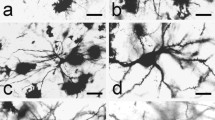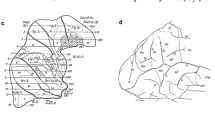Summary
A map of the areal pattern of the hyperstriatum ventrale in the domestic pigeon (Columba livia f.d.) is proposed. This map is based mainly on the distribution of the grey level index which has been characterized using an automatic image analyzer. Twelve areas are described. They are classified into two groups (Hvm 1–6, Hvl 1–6) which are defined by a different range of grey level indices. Three of these areas show topographic relationships to primary projection areas in the neighbouring neostriatum (Nucleus basalis, Ectostriatum, Feld L), and connections are in part well known. Therefore, these areas are assumed to be associative in function. The function of the other areas remains an open question.
Similar content being viewed by others
References
Bonke BA, Bonke D, Scheich H (1979) Connectivity in the auditory forebrain nuclei in the guinea fowl (Numida meleagris). Cell Tissue Res 200:101–121
Humm A (1883) Das Großhirn der Vögel. Z wiss Zool 38:430–467
Craigie EH (1928) Observations of the brain of the humming bird (Chrysolampis mosquitus Linn and Chlorostilbon caribaeus Lawr). J Comp Neurol 45:377–481
Craigie EH (1930) Studies on the brain of the kiwi Apteryx australis. J Comp Neurol 49:223–357
Craigie EH (1932) The cell structure of the cerebral hemisphere of the humming bird. J Comp Neurol 56:135–168
Dubbeldam JL (pers comm) Neural circuits of the feeding system in birds. Lecture Int Symp Vertb Morphol Giessen (1983)
Ourward A (1932) Observations on the cell masses in the cerebral hemisphere of the New Zealand kiwi (Apteryx australis). J Anat 66:437–477
Edinger L, Wallenberg A, Holmes G (1903) Untersuchungen über die vergleichende Anatomie des Gehirns. 5. Das Vorderhin der Vögel. Abh Senckenbg naturf Ges 20:343–426
Huber GC, Grosby EC (1929) The nuclei and fiber paths of the avian diencephalon, with consideration of telencephalic and certain mesencephalic centres and connections. J Comp Neurol 48:1–225
Kappers CUA (1922) The ontogenetic development of the corpus striatum in birds and a comparison with mammals and man. Proc Kon Akad Wetensch Amsterdam 26:135–158
Karten HJ (1968) The ascending auditory pathway in the pigeon (Columba livia). II. Telencephalic projections of the nucleus ovoidalis thalami. Brain Res 11:134–158
Karten HJ (1970) Telencephalic projections of the nucleus rotundus in the pigeon (Columba livia). J Comp Neurol 140:35–52
Kuhlenbeck H (1938) The ontogenetic development and phylogenetic significance of the cortex telencephali in the chick. J Comp Neurol 69:273–301
Kuhlenbeck H (1977) The central nervous system of vertebrates. Vol 5, part I. Karger, Basel München London New York Sydney
Maier V, Scheich H (1983) Acoustic imprinting leads to differential 2-deoxy-D-glucose uptake in the chick forebrain. Proc Natl Acad Sci USA 80:3860–3864
Müller ChM (1981) Reaktionen von Neuronen im caudalen Telencephalon des Staren auf Rauschbänder unterschiedlicher Breite und Mittenfrequenz. Diplomarbeit Bochum
Necker R (1983) Somatosensory system. In: Abs M (ed) Physiology and behaviour of the pigeon. Academic Press, London, 169–192
Necker R, Rehkämper G (1982) Somatosensory projection fields in the telencephalon of the pigeon: topography and afferent connections. Pflügers Arch Suppl 394:R 58
Nottebohm F, Stokes T, Leonard C (1976) Central control of song in the canary, Serinus canarius. J Comp Neurol 165:457–486
Paton J, Manogue KR, Nottebohm F (1981) Bilateral organization of the vocal control pathway in the budgerigar, Melopsittacus undulatus. J Neurosc 1:1279–1288
Pearson R (1972) The avian brain. Academic Press, London
Rehkämper G, Necker R (1982) Somatosensorische Zentren im Endhirn der Taube und ihre afferenten Verbindungen. Verh Dtsch Zool Ges, 256
Romeis B (1968) Mikroskopische Technik. Oldenbourg, München Wien
Rose M (1914) Über die cytoarchitektonische Gliederung des Vorderhirns der Vögel. J Psychol Neurol 21:278–352
Scheich H, Bonke BA, Bonke D, Langner G (1979) Functional organization of some auditory nuclei in the guinea fowl demonstrated by the 2-deoxyglucose technique. Cell Tisse Res 204:17–27
Schleicher A, Zilles K, Kretschmann H-J (1978) Automatische Registrierung und Auswertung eines Grauwertindex in histologischen Schnitten. Verh Anat Ges (Jena) 72:413–415
Starck D (1982) Vergleichende Anatomie der Wirbeltiere. Bd 3, Springer, Berlin Heidelberg New York
Stingelin W (1956) Studien am Vorderhin von Waldkauz (Strix aluco L) und Turmfalk (Falco tinnunculus L.). Rev Suis Zool 63:551–660
Stingelin W (1958) Vergleichend morphologische Untersuchungen am Vorderhirn der Vögel auf cytologischer und cytoarchitektonischer Grundlage. Helbig und Lichtenhahn, Basel
Veenman CL, Gottschaldt KM (1983) Organization of the nucleus basalis-neostriatum complex in the goose, Anser anser. Anat Anz 153:296
Wallenberg A (1902) Eine zentrifugal leitende direkte Verbindung der frontalen Vorderhirnbasis mit der Oblongata (+ Rückenmark?) bei der Ente. Anat Anz 22:289–292
Wallenberg A (1903) Der Ursprung des Tractus isthmo-striatus (oder bulbo-striatus) der Taube. Neurol Zbl 22:98–101
Wree A, Zilles K, Schleicher A (1981) A quantitative approach to cytoarchitectonics. VII. The areal pattern of the cortex of the guinea pig. Anat Embryol 162:81–103
Zilles K, Rehkämper G, Schleicher A (1979a) A quantitative approach to cytoarchitectonics. V. The areal pattern of the cortex of Microcebus murinus (E Geoffroy 1828), (Lemuridae, Primates). Anat Embryol 157:269–289
Zilles K, Rehkämper G, Stephan H, Schleicher A (1979b) A quantitative approach to cytoarchitectonics. IV. The areal pattern of the cortex of Galago demidovii (E Geoffroy 1796), (Lorisidae, Primates). Anat Embryol 157:81–103
Zilles K, Zilles B, Schleicher A (1980) A quantitative approach to cytoarchitectonics. VI. The areal pattern of the cortex of the albino rat. Anat Embryol 159:353–360
Author information
Authors and Affiliations
Additional information
Dedicated to Dr. H. Stephan, Frankfurt/Main, on the occasion of his 60th birthday
Supported by Deutsche Forschungsgemeinschaft (SFB 114, Zi 192/4-4)
Rights and permissions
About this article
Cite this article
Rehkämper, G., Zilles, K. & Schleicher, A. A quantitative approach to cytoarchitectonics. Anat Embryol 169, 319–327 (1984). https://doi.org/10.1007/BF00315637
Accepted:
Issue Date:
DOI: https://doi.org/10.1007/BF00315637




